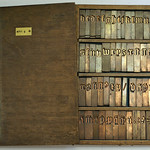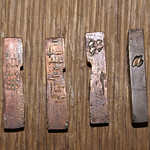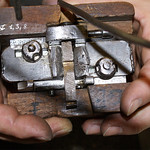The purpose of the systems and models that I have defined during my research is to map the aspects and elements that together determine the shapes and consistency of the graphemes used to represent the Latin script, that is, letters and characters, and the way they interact. The division of scripts into the systems and models, as shown in the diagram below, is therefore specifically intended to illustrate the Latin script, although (parts of) the division may also apply to other scripts. However, this is outside the scope of my research.
Please note that the classification used here appears in some cases to conflict with the traditional, actually quite crude, nomenclature used in the practice of the calligrapher, type designer, and typographer. For example, the term ‘roman type’ includes both capital and minuscule letters. The term ‘textura type’ includes both the majuscules and the minuscules. But this clash of classifications simply marks the difference between science and the general workplace; for a detailed description of the underlying patterns and structures of letters, and subsequently of the typography, a more sophisticated indexing is required.

Block diagram showing (the relation between) scripts and derived systems and models
Scripts are the top of a system that consists of writing systems, graphemes, grapheme systems, harmonic systems (which can be subdivided into harmonic models), relational systems, proportional systems (which can be subdivided into proportional models), and rhythmic systems. Scripts may be related, such as the Cyrillic script that shares elements of the Latin and Greek scripts.
Writing system is the orthographic term for a collection of graphemes and subsequent rules needed to represent one or more (by definition related) languages. Translated into typographical terms, a writing system contains glyphs, which are formalized and fixed (‘fixed’ as a synonym for incised or engraved) language-specific graphemes.
Graphemes are the units that make up a writing system. They are, in principle, generally the graphic equivalents of phonemes, i.e., the basic units of spoken language. Graphemes consist of letters, syllables, characters, numerals, and punctuation marks (of which there are no equivalents in speech). One can think of this set as a container with all variants of all informal and formal grapheme variants, that is, grapheme systems, used or in use for a writing system, such as capital, uncial, textura, rotunda, Humanistic minuscule, roman type, italic type, fraktur, and so on.
Graphemes in their written form are modular by definition, because they result from the repeated application of relatively limited movements made with a particular writing instrument. In their typographical form, graphemes exhibit the same modularity as a result of the transformation of the handwritten forms into formal variants. The extent to which graphemes form coherent groups depends on how consistent these movements are. Some graphemes can be (unintentionally) made smaller or wider than others, which hinders the rhythm somewhat.
Grapheme systems are collections of graphemes that share general constructive aspects. The combined graphemes do not necessarily have to share the same morphological background; they can be ‘glued’ together by design, that is, by adjusting details (see: Harmonic models below). For example, the combination of graphemes of different morphological origins in a grapheme system can be the result of an evolutionary process, but also of the direct interference of scholars, such as the influence of Alcuin of York on the formation of the Carolingian minuscule. In Greek and Latin script, the core of each grapheme system is the alphabet.
The grapheme systems, whether calligraphic or typographic, used to represent the Latin script since the invention of movable type are capital, uncial, bookhand minuscule, and cursive minuscule. Every grapheme system includes variants, that is, harmonic systems, which are often the result of evolutionary processes. These variants have the same general morphology, but their details are different, such as inscribed, written, and typographical variants.
It should be noted that the role of the grapheme system uncial has been relatively minor, and its current use is limited to Gaelic, of which the Celtic language has Irish and Scots variants.
Harmonic systems are formed by specific variants of grapheme systems. Because they are subdivisions of grapheme systems, harmonic systems by definition share the same basic structure, but differ in proportions and/or details. For example, the the grapheme system Latin capital includes the harmonic systems Roman Imperial capitals and roman-type capitals. These two harmonic systems differ in proportions and details, such as the shape of the serifs, but they share the same basic structure. The written Renaissance capital letters incorporated into the Humanistic minuscule also form a separate harmonic system within the grapheme system capital, because they differ in details from, for example, the lapidary and typographic capital letters. Yet the written capital letters share the same morphology as the regularized and formalized variants. Greek capitals are part of a different grapheme system due to their largely different shapes.
The same subdivision as for the grapheme system capitals can be made for the grapheme system bookhand minuscules. The minuscules of texture (type), rotunda (type), Humanistic minuscule, and the lowercase part of roman type are harmonic systems within this grapheme system. The minuscules of bastarda, schwabacher, fractur, Humanistic cursive, and italic type form different harmonic systems, all of which are part of the grapheme system cursive minuscule.
Harmonic models are subdivisions of harmonic systems based on the morphological origin of the combined graphemes. The consistency of a harmonic system depends on the number of harmonic models it includes. For example, the lowercase of roman type contains two harmonic models. There is a primary, that is dominant, one for all letters except the k, s, and v-z range. The letters that make up the primary harmonic model are all made up of the same basic elements. The exceptions are the secondary harmonic model: these letters have a different morphological background, because they originate from the grapheme system capitals.
Relational systems include the (relative) boldness or weight and the amount of contrast in the graphemes. In terms of the broad nib, it describes the relationship between the nib width and the x-height, and the relationship between the nib width and the nib thickness.
Proportional systems describe the relationship between the x-height and the width of the graphemes. It also describes the relationship between the size of the x-height and the lengths of the ascenders and descenders. These aspects are recorded in Proportional models (see below). Proportional systems can also include cross-grapheme system information, such as the relationship between the proportions of a bookhand’s minuscules and its corresponding capitals (or majuscules, as appropriate). These aspects are recorded in dynamic em-squares (see also: Patterns and Grids).
Proportional models define the degree of compression or expansion in the primary harmonic models. In a harmonic model there may be more than one proportional model, which theoretically indicates that there is an inconsistency in the construction (read: design). In that case there is usually a primary, i.e., dominant, proportional model and a secondary one.
Rhythmic systems define the intervals of the stems and the relationship between the counters and the space between the graphemes, that is, the spacing (fitting). This means, for example, that a change in the proportional system will lead to an increase or decrease in spacing, because the rhythmic system changes. Regardless of the number of proportional systems, there can only be one rhythmic system in a harmonic system, otherwise the spacing will result in separated, i.e., isolated, groups of graphemes.
All systems work directly with each other and influence each other. For example, the application of multiple proportional systems will result in counters of different sizes, and will then by definition hinder the rhythmic system.




